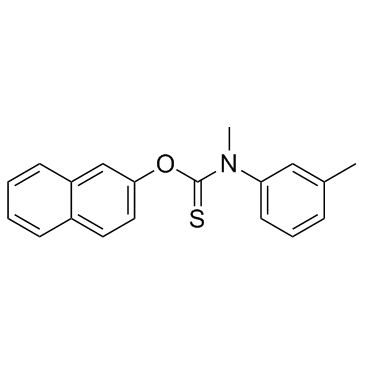Studies on the mode of action of tolnaftate in Microsporum gypseum.
M P Gupta, N Kapur, I Bala, G K Khuller
文献索引:J. Med. Vet. Mycol. 29(1) , 45-52, (1991)
全文:HTML全文
摘要
Studies were performed on the mode of action of tolnaftate and resistance to this drug in Microsporum gypseum. Cells grown in the presence of tolnaftate (at the IC 50) showed a reduced content of total phospholipids and sterols whereas there was an increase in total RNA content. Incubation of cells with tolnaftate (at 10 x MIC), followed by addition of different macromolecule precursors revealed inhibition of the biosynthesis of all macromolecules except for RNA. The activity of membrane-bound enzymes did not change on treatment with tolnaftate (10 x MIC) whereas an increase in the leakage of intracellular 32P was observed. The content of total phospholipids was higher in tolnaftate-resistant cells, whereas the content of total sterols, DNA, RNA and protein was comparable to that of susceptible cultures. Activity of phosphodiesterase decreased and 5'-nucleotidase increased in tolnaftate-resistant cells. Our results suggest that the antifungal activity of tolnaftate is due to differential action on various targets site(s) which are modified in strains resistant to the drug.
相关化合物
| 结构式 | 名称/CAS号 | 分子式 | 全部文献 |
|---|---|---|---|
 |
托萘酯
CAS:2398-96-1 |
C19H17NOS |
|
Characterization of iprodione resistance in Botrytis cinerea...
2014-04-01 [Phytopathology 104(4) , 396-402, (2014)] |
|
DrugBank 3.0: a comprehensive resource for 'omics' research ...
2011-01-01 [Nucleic Acids Res. 39 , D1035-41., (2011)] |
|
A randomised controlled trial of active chronic otitis media...
2012-08-01 [Clin. Otolaryngol. 37(4) , 261-70, (2012)] |
|
X-ray powder diffractometric method for quantitation of crys...
2002-04-01 [J. Pharm. Sci. 91(4) , 983-90, (2002)] |
|
Assay of tolnaftate and related impurities by isocratic supe...
2000-05-01 [Fresenius J. Anal. Chem. 367(1) , 91-3, (2000)] |